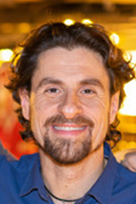Title
Overview of MPEG-5 Part 2 - Low complexity enhancement video coding (LCEVC)
Abstract
This paper provides an overview of MPEG-5 Part 2 Low
Complexity Enhancement Video Coding (LCEVC), a novel video coding standard from
the MPEG ISO Working Group. The codec is designed for use in conjunction with
existing video codecs, leveraging specific tools for encoding
"residuals", i.e. the difference between the original video and its
compressed representation. LCEVC can improve compression efficiency and reduce
the overall computational complexity using a small number of specialized
enhancement tools. This paper provides an outline of the coding structure of
encoder and decoder, coding tools, and an overview of the performance of LCEVC with
regard to both compression efficiency and processing complexity.
Keywords
Low complexity enhancement video coding (LCEVC), MPEG-5 Part 2, multi-resolution video coding, video compression
Authors
 Florian Maurer
Florian Maurer
RWTH Aachen University, Germany
Florian Maurer has studied Electrical Engineering, Information Technology and Computer Engineering at RWTH Aachen University (Germany) and will finish his Master of Science degree in 2020. He has focused his studies on signal processing with a particular interest in video coding and gained industry experience while working for a leading company in video compression. During his work at RWTH Institute of Communications Engineering chaired by Prof. Jens-Rainer Ohm, he acquired comprehensive knowledge of different video coding standards. Florian was involved in the standardization process of MPEG‐5 Part 2 — Low Complexity Enhancement Video Coding (LCEVC). His contributions helped to move LCEVC forward to the "Draft International Standard (DIS)" stage and he has taken part in the development of a reference implementation of LCEVC. Recently, he has also shown interest in graph signal processing (GSP) and is researching motion estimation in dynamic 3D point cloud sequences.
 Stefano Battista
Stefano Battista
Università Politecnica delle Marche (UNIVPM), Italy
Stefano
Battista received his Laurea degree in Electronic Engineering from the
Università Politecnica delle Marche, Italy, in 1990. From 1991
to 1997, he was a Researcher with Telecom Italia Lab, Torino, Italy, with the
Video and Multimedia group. His main activities have been on Video coding,
Video analysis, 3d modelling, Multimedia systems, with a focus on
standardisation for multimedia communications. From 1997
to 1999, he was a System Engineer with STMicroelectronics, Agrate, Milano,
Italy, with the Advanced Systems Technology group. His main activities were in
the development of new architectures for multimedia consumer products,
specifically on DVB/DVD platforms and their evolution towards interactive TV. From 1999
to 2018, he was a Researcher and System Engineer with bSoft, Macerata, Italy,
where he has been active in Research & Development. Stefano
Battista has published several research papers on video coding and multimedia
systems, and contributed to books related to the fields of communications and
multimedia. He actively
participated in the standardisation effort of MPEG, in particular to MPEG-4
Reference Software development, co-authoring part 5 of the standard. For this
contribution to the standardisation activity he received an ISO Certificate of
Appreciation.He contributed
to co-operative research projects in the 3rd (RACE), 4th (ACTS), 5th (IST), 6th
and 7th (ICT) Framework Programs of the European Commission. He served as
consultant for several companies in Italy and abroad, and as external evaluator
and reviewer for the European Commission.
 Lorenzo Ciccarelli
Lorenzo Ciccarelli
V-Nova, UK
Lorenzo Ciccarelli received his Laurea degree in Electronic Engineering and Telecommunication from the Università Politecnica delle Marche, Italy, in 1998 with a final Master degree thesis on video coding and in particular working on algorithm optimization for H.263+ video codecs. From 1999 to 2006 he has been working on several aspects of video compression algorithm design and implementation participating and leading projects focused on developing codecs on different VLIW architecture mainly used for videoconference terminal and multiconference unit. In 2006 he moved to United Kingdom joining Ericsson SATTV (former Tandberg TV) R&D department where he had the opportunity to deepen his knowledge of the TV broadcasting side of the video coding gaining expertise in rate control and statmuxing while porting video compression algorithm on FPGAs. Between 2008 and 2014 he has been involved several projects to design software test models used to design, test and improve different algorithms based on MPEG2, AVC and HEVC for large broadcasting systems based on multiple FPGA, DSPs and CPUs. Between 2014 and 2016 he was leading the design of one of the first hardware implementation of a HEVC full UHD encoder based on hybrid x86 and FPGA architecture to then join BBC Video coding RD where he spent 2 years in improving internal video encoding testing platform (Turing encoder) and working on different European funded projects. In 2018 he joined V-Nova Ltd with the title of Principal Research Engineer. During the last 2 years he a has been involved in the algorithm design and standardization process for MPEG5-Part2 LCEVC.
 Guido Meardi
Guido Meardi
V-Nova, UK
Guido is
co-founder and CEO of V-Nova, leading company in data compression and
Artificial Intelligence. Guido is a keen innovator, entrepreneur and investor,
with relevant business building experience and half a dozen exits. Having
retained in-depth scientific and engineering expertise, he contributed to the
foundational development work for the V-Nova Intellectual Property portfolio
and is inventor or joint inventor of several essential aspects of the coding
standards MPEG-5 Part 2 Low Complexity Enhancement Video Coding (LCEVC) and
SMPTE VC-6 ST-2117, with over 200 patents filed. Former
senior Partner at McKinsey, where he was head of the Organization and
Operations Practices of the Mediterranean Complex, Guido also has a breadth of
business experience and access to senior executives in a variety of industries
and geographies, with well-established experience in telecoms, technology,
healthcare, insurance, banking, automotive, aerospace and defence. He led
transformational projects in all continents, and was instrumental in setting up
some of McKinsey’s own innovation-related business building activities. Guido holds
an MBA from MIT Sloan, where he was a Siebel scholar, and a M.Sc. in Computer
Engineering from Politecnico di Milano, where he was an Intel scholar, and
University of Texas at Austin.
 Simone Ferrara
Simone Ferrara
V-Nova, UK
Simone Ferrara is Senior Vice President at V-Nova, where he is responsible for the technology, IP and standardization strategy, including driving its execution across the company. Simone has been leading the development of MPEG-5 Part 2 Low Complexity Enhancement Video Coding and has contributed to many of the coding tools included in the standard. Prior to V-Nova, Simone worked in the telecommunications industry first as a researcher and then as an IP expert. He graduated from Politecnico di Milano in Telecommunications Engineering, and subsequently obtained an MSc in Electrical Engineering from Washington University in St. Louis (USA).